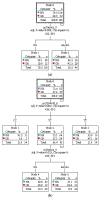A Comparison of Different Approaches to Clinical Phenotyping of Lithium Response: A Proof of Principle Study Employing Genetic Variants of Three Candidate Circadian Genes
- PMID: 34832854
- PMCID: PMC8625673
- DOI: 10.3390/ph14111072
A Comparison of Different Approaches to Clinical Phenotyping of Lithium Response: A Proof of Principle Study Employing Genetic Variants of Three Candidate Circadian Genes
Abstract
Optimal classification of the response to lithium (Li) is crucial in genetic and biomarker research. This proof of concept study aims at exploring whether different approaches to phenotyping the response to Li may influence the likelihood of detecting associations between the response and genetic markers. We operationalized Li response phenotypes using the Retrospective Assessment of Response to Lithium Scale (i.e., the Alda scale) in a sample of 164 cases with bipolar disorder (BD). Three phenotypes were defined using the established approaches, whilst two phenotypes were generated by machine learning algorithms. We examined whether these five different Li response phenotypes showed different levels of statistically significant associations with polymorphisms of three candidate circadian genes (RORA, TIMELESS and PPARGC1A), which were selected for this study because they were plausibly linked with the response to Li. The three original and two revised Alda ratings showed low levels of discordance (misclassification rates: 8-12%). However, the significance of associations with circadian genes differed when examining previously recommended categorical and continuous phenotypes versus machine-learning derived phenotypes. Findings using machine learning approaches identified more putative signals of the Li response. Established approaches to Li response phenotyping are easy to use but may lead to a significant loss of data (excluding partial responders) due to recent attempts to improve the reliability of the original rating system. While machine learning approaches require additional modeling to generate Li response phenotypes, they may offer a more nuanced approach, which, in turn, would enhance the probability of identifying significant signals in genetic studies.
Keywords: bipolar disorder; circadian genes; genetics; lithium; machine learning; phenotype; response.
Conflict of interest statement
B.E. has received honoraria for consulting from Sanofi in the last three years. F.B. is an advisor on mental health to the French government. All other authors have no declarations regarding this work.
Figures


Similar articles
-
Circadian genes and lithium response in bipolar disorders: associations with PPARGC1A (PGC-1α) and RORA.Genes Brain Behav. 2016 Sep;15(7):660-8. doi: 10.1111/gbb.12306. Epub 2016 Aug 2. Genes Brain Behav. 2016. PMID: 27324142
-
Can actigraphy be used to define lithium response dimensions in bipolar disorders?J Affect Disord. 2021 Mar 15;283:402-409. doi: 10.1016/j.jad.2021.01.060. Epub 2021 Feb 2. J Affect Disord. 2021. PMID: 33581466
-
An examination of the quality and performance of the Alda scale for classifying lithium response phenotypes.Bipolar Disord. 2020 May;22(3):255-265. doi: 10.1111/bdi.12829. Epub 2019 Sep 23. Bipolar Disord. 2020. PMID: 31466131
-
Genetic influences on response to mood stabilizers in bipolar disorder: current status of knowledge.CNS Drugs. 2013 Mar;27(3):165-73. doi: 10.1007/s40263-013-0040-7. CNS Drugs. 2013. PMID: 23378337 Free PMC article. Review.
-
[Circadian markers and genes in bipolar disorder].Encephale. 2015 Sep;41(4 Suppl 1):S38-44. doi: 10.1016/S0013-7006(15)30005-1. Encephale. 2015. PMID: 26746321 Review. French.
Cited by
-
Methylomic biomarkers of lithium response in bipolar disorder: a clinical utility study.Int J Bipolar Disord. 2023 Apr 29;11(1):16. doi: 10.1186/s40345-023-00296-6. Int J Bipolar Disord. 2023. PMID: 37119343 Free PMC article.
References
-
- Verdolini N., Hidalgo-Mazzei D., Del Matto L., Muscas M., Pacchiarotti I., Murru A., Samalin L., Aedo A., Tohen M., Grunze H., et al. Long-term treatment of bipolar disorder type I: A systematic and critical review of clinical guidelines with derived practice algorithms. Bipolar Disord. 2021;23:324–340. doi: 10.1111/bdi.13040. - DOI - PubMed
-
- Malhi G.S., Bell E., Boyce P., Bassett D., Berk M., Bryant R., Gitlin M., Hamilton A., Hazell P., Hopwood M., et al. The 2020 Royal Australian and New Zealand College of psychiatrists clinical practice guidelines for mood disorders: Bipolar disorder summary. Bipolar Disord. 2020;22:805–821. doi: 10.1111/bdi.13036. - DOI - PubMed
-
- Laroche D.G., Etain B., Severus E., Scott J., Bellivier F. Socio-demographic and clinical predictors of outcome to long-term treatment with lithium in bipolar disorders: A systematic review of the contemporary literature and recommendations from the ISBD/IGSLI Task Force on treatment with lithium. Int. J. Bipolar Disord. 2020;8:40. doi: 10.1186/s40345-020-00203-3. - DOI - PMC - PubMed
Grants and funding
LinkOut - more resources
Full Text Sources
Miscellaneous

